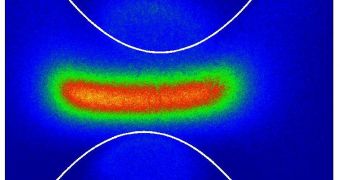An electric arc is an electrical breakdown of a gas which produces an ongoing plasma discharge, similar to the instant spark, resulting from a current flowing through normally nonconductive media such as air. An archaic term is voltaic arc as used in the phrase "voltaic arc lamp".
Whether it's a lightning bolt or the spark inside a bad switch, or a spark flying between a metal doorknob and your hand, the process is the same: the voltage across a region of air becomes large enough to drive an electric current by creating a plasma. The process starts when a few stray electrons - accelerated by the electric field - knock into atoms and liberate more electrons, which continue the process. In carefully designed lab experiments, the region between a pair of electrodes fills with plasma smoothly, starting at the positive end, with a wave front that sweeps quickly across to the negative end.
Researchers report the first direct measurements of the sharply changing electric fields that pave the way for a visible flash in a precisely controlled laboratory arc. Their results provide concrete detail in an area where theoretical modeling remains scanty, and may offer a way to study electrical discharges in settings ranging from plasma televisions to lightning strikes.
Gerrit Kroesen of the Eindhoven University of Technology in the Netherlands and his colleagues, in their experiment designed to get better electric field data, studied plasma creation between two broad electrodes separated by a few millimeters in a low-pressure xenon gas.
During the microsecond-long transit of the ionization front, they shined brief pulses from two lasers into the gap. The first pulse made gas atoms emit fluorescent light, as electrons were excited to higher levels and fell back. The second laser pulse pushed already excited electrons to a still higher level, one whose energy depended upon the electric field. To get electrons to that field-dependent level required using just the right frequency of light - and therefore, the right photon energy - for the second pulse.
Finding that frequency, by looking for a reduction in fluorescence from intermediate levels, revealed the local electric field for the excited atoms. Although this principle is straightforward, getting the experiment to work was a "painstaking process," Kroesen says. "It took us four years."

 14 DAY TRIAL //
14 DAY TRIAL //